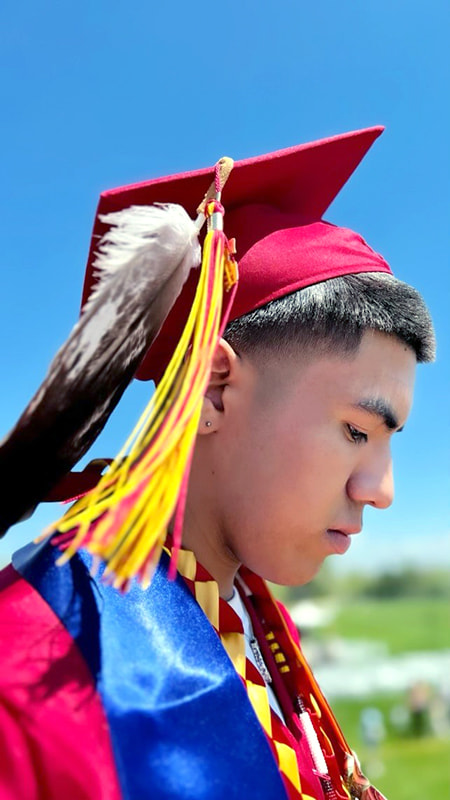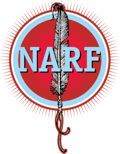
NARF has developed two flyers to assist students and families who want to wear eagle feathers at their graduation ceremonies.
- Wearing Eagle Feathers at Graduation: A Guide for Students and Families provides guidance on how to work with school districts to make the request.
- Wearing Eagle Feathers at Graduation: Information for Schools teaches schools about the significance that eagle feathers and plumes hold for Native students.
Find legislation, court cases, and other related resources below on this page.
Many Tribal Nations recognize leadership achievements by bestowing the person who earned the honor an eagle feather or plume. While tribal religions and spiritual practices vary from each other, in general, a Native person who wears a plume or eagle feather at a public event has done something amazing to show that they have the maturity to pray and care for themselves and others.
Some Native American students seek to express their religious beliefs and celebrate their academic achievements by wearing an eagle feather at their graduation ceremonies. While most public school districts permit Native students to wear eagle feathers, some do not. Once schools come to understand the religious, cultural, and academic significance of eagle feathers, most make accommodations and exceptions for Native American students. This guide shares steps to help high school graduates successfully wear eagle feather during their commencement ceremony. We urge concerned families to seek legal advice on their specific case.
STEPS YOU CAN TAKE TO WEAR YOUR REGALIA AT GRADUATION:
- REVIEW POLICY EARLY. Consult handbooks and school administrators about your school’s policies. Ask how to get an exception or religious accommodation if needed. Requesting permission and appealing unfavorable decisions can take time, so start early.
- REQUEST PERMISSION. Follow procedures for requesting exceptions or religious accommodations to the graduation dress code. If your school doesn’t have an eagle feather policy or prohibits eagle feathers, request permission from your principal. If your school has a religious accommodation policy, use it to make your request. If your request is denied, follow your school’s appeal or grievance process, which is probably in your student handbook. This may include appealing to your district superintendent or school board.
- ORGANIZE A NATIVE STUDENT GROUP. Some schools permit student organizations (e.g. Honor Society, Future Farmers of America) to approve or distribute graduation regalia. Forming a Native student group may mean your school will permit eagle feathers at graduation.
- DO NOT IGNORE RULES AGAINST EAGLE FEATHERS. Violating school rules can have negative consequences. Your school may ban you from participating in commencement, subject you to fines, or refuse to give you your diploma.
- EDUCATE YOUR SCHOOL AND DISTRICT. It is critical to educate your school administration about the religious and cultural significance of eagle feathers. Bring this flyer with you and raise the points below.
- GATHER SUPPORT. Request letters and support from Indian education parent committees or program administrators, tribal leaders or education departments, or elders and other community members. They can advocate for you and help explain why it is culturally and religiously important for Native students to wear eagle feathers during graduation.
- ADVOCATE FOR POLICY CHANGES. You are likely not the only student to request to wear an eagle feather at graduation, especially if there is a sizeable Native population. Petition your school board to change graduation policies to permit Native students to wear eagle feathers in line with their religious beliefs and traditions.
POINTS YOU CAN MAKE TO SCHOOL OFFICIALS:
EAGLE FEATHERS ARE RELIGIOUSLY IMPORTANT: Many Tribal Nations hold eagles and their feathers sacred. Highly revered, eagle feathers represent honesty, truth, majesty, strength, courage, wisdom, power, and freedom. Federal law and policy has long-recognized this religious importance.
EAGLE FEATHERS CARRY SIGNIFICANCE: Eagle feathers are given in times of great honor. Many Tribes present eagle feathers upon graduation to recognize this educational milestone and reflect the honor the graduate brings to their family, community, and Tribal Nation. For many Native students, receiving an eagle feather is as significant as earning a diploma or an honor society stole, which typically are permitted at graduation.
IT’S THE LAW: The U.S. Constitution protects Native American religious and free speech rights. Currently, state laws in AK, AZ, CA, CO, IL, KS, MI, MN, MS, MT, NC, NE, NM, NV, ND, OK, OR, SD, UT, and WA also protect Native students’ rights to wear eagle feathers and other tribal regalia at graduation.
Even if a policy applies to all students, uneven enforcement can constitute a violation of a Native student’s religious and free speech rights. Disallowing eagle feathers, while allowing or tolerating secular or other religions’ decorations, messages, or regalia at graduation can transform a “generally applicable” policy into a selective policy that discriminates based on religion, in violation of the Constitution.
Federal Resources
The U.S. Constitution’s Free Exercise Clause protects religious practices and recognize the exercise of religion as an unalienable right. The Free Speech Clause of the Constitution also protects the right to free speech. Wearing an eagle feather or regalia to show academic success and religious beliefs should be considered protected practices, and Native students should not be singled out for unique treatment.
The federal government has long considered eagle feathers religious objects. In 1994, the White House issued a Policy Concerning Distribution of Eagle Feathers for Native American Religious Purposes.
State Resources
Alaska
- AS § 14.03.135(a)(4) – Prevents a governing body from adopting school dress codes that prohibit a student from wearing regalia or objects of cultural significance at a graduation ceremony.
Arizona
- Ariz. Rev. Stat. Ann. § 15-348 – A school “may not prohibit a student who is a member of a federally recognized Indian Tribe or who is eligible to be enrolled as a member of a federally recognized Indian Tribe from wearing traditional tribal regalia or objects of cultural significance at a graduation ceremony.”
California
- Education Code § 35183.1 – Wearing of Traditional Tribal Regalia or Recognized Objects of Religious or Cultural Significance as an Adornment at School Graduation Ceremonies; “A pupil may wear traditional tribal regalia or recognized objects of religious or cultural significance as an adornment at school graduation ceremonies.”
Colorado
- Colo. Rev. Stat. § 22-1-142 – Tribal regalia at school graduation ceremonies – “A school or school district shall not prohibit a qualifying student or the qualifying student’s immediate family from wearing and displaying tribal regalia at a graduation ceremony.”
Illinois
- 105 Ill. Comp. Stat. 5/10-22.25b(iv) – School uniform or dress code polices may not “prohibit the right of a student to wear or accessorize the student’s graduation attire with items associated with the student’s cultural, ethnic, or religious identity. . .”
Kansas
- Kan. Stat. Ann. § 60-5321(b) – Prohibits any state agency or municipality, including school districts, from prohibiting an individual from wearing traditional tribal regalia or objects of cultural significance at a public event, including public education graduation ceremonies.
Michigan
- Mich. Comp. Laws Ann. § 380, 1300 “The board of a school district or intermediate school district or board of directors of a public school academy shall ensure that a Native American individual is permitted to wear traditional regalia and to bring traditional objects to ceremonies of honor.”
Minnesota
- Minn. Stat. § 124D.792 – Graduation Ceremonies; Tribal Regalia and Objects of Cultural Significance – “A school district or charter school must not prohibit an American Indian student from wearing American Indian regalia, Tribal regalia, or objects of cultural significance at a graduation ceremony.”
Mississippi
- Miss. Code § 11-61-3 – Prohibits any governmental entity, political subdivision, or official/person acting under color of Mississippi law from prohibiting an individual from wearing traditional tribal regalia or objects of cultural significance at any public event, including public education graduation ceremonies.
Montana
- MCA § 2-1-315 – Tribal Regalia and Objects of Cultural Significance – Allowed at Public Events; “A state agency or a local government may not prohibit an individual from wearing traditional tribal regalia or objects of cultural significance at a public event.”
Nebraska
- Neb. Stat. Rev. § 79-2,160 – No later than July 1, 2025, school districts must adopt a dress code policy consistent with the state’s model policy, which states that schools shall not prohibit tribal regalia and religious attire.
Nevada
- Nev. Rev. Stat. § 388.915 – “A pupil of a public school, including, without limitation, a pupil of a university school for profoundly gifted pupils, is entitled to wear traditional tribal regalia or recognized objects of religious or cultural significance as an adornment at a school graduation ceremony.”
New Mexico
- N.M. Stat. Ann. Section 22-5-4.3: Public and charter schools “shall not prohibit a student who is enrolled, or eligible for enrollment, in a federally recognized Indian nation, tribe or pueblo from wearing tribal regalia or objects of cultural significance along with or attached to a cap or gown or wearing tribally significant footwear or other items of apparel under a gown at graduation ceremonies or public school events.”
North Carolina
- N.C. Gen. Stat. § 115C-407.40 – Cultural expression at graduation ceremonies – Allows students enrolled or eligible for enrollment in a State or federally recognized tribe to “wear objects of cultural significance,” including bird feathers and plumes, as a part of their regalia at graduation.
North Dakota
- N.D. Cent. Code Ann. § 15.1-19-28 – “The board of a school district or a school may not establish a dress code policy that includes prohibiting a student from wearing traditional tribal regalia or objects of cultural significance at a graduation ceremony.”
Oklahoma
- Okl. Stat. Ann. tit. 70 § 24-160 – “A student enrolled in a public school district, a public charter school, or a technology center school may wear tribal regalia during the school’s official graduation ceremonies, whether held at a public or private location.”
- Oklahoma Religious Freedom Act, Okla. Stat. Ann. tit. 51, § 251 et seq.
- Attorney General Hunter letter about eagle feathers at graduation (October 23, 2018)
- Attorney General Hunter letter about eagle feathers at graduation (May 8, 2019)
Oregon
- Or. Rev. Stat. Ann. § 332.112 – “A school district may not prohibit a student from wearing Native American items of cultural significance at a public school event.”
- Director of the Oregon Department of Education Colt Gill Letter (May 6, 2019)
South Dakota
- SDCL § 13-1-66 – The State “shall not prohibit any person from wearing traditional tribal regalia or objects of cultural significance at a school honoring or graduation ceremony.”
Utah
- Utah Code Ann. § 53G-4-412 – Tribal regalia at high school graduation ceremonies – Any student who is an enrolled member of a federal or state recognized tribe or eligible for enrollment in a federal or state recognized tribe may wear tribal regalia during their graduation ceremony. A public school district “may not prohibit a qualifying student from wearing tribal regalia[.]”
Washington
- Wash. Rev. Code Ann. § 28A.600.500 – “School districts and public schools may not prohibit students who are members of a federally recognized tribe from wearing traditional tribal regalia or objects of Native American cultural significance along with or attached to a gown at graduation ceremonies or related school events.”
- Superintendent of Public Education Chris Reykdal Letter (May 28, 2018)
Court Cases
- Lena’ Black v. Broken Arrow School District
- Goodall v. Midway Independent School District
- Titman v. Clovis Unified School District
- Waln v. Dysart School District
Scholarship & Materials
NARF has a long history of assisting students who are prohibited from wearing eagle feathers at graduation ceremonies due to narrow graduation dress codes. We continue to advocate for these graduates so they can celebrate their great successes without sacrificing their tribal identity. Learn more about our work on our related case page: Protecting Native Students’ Rights at Graduation.
More Resources

